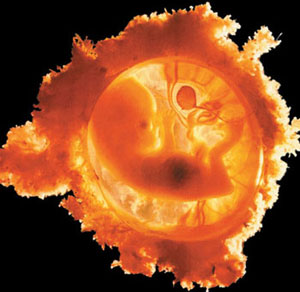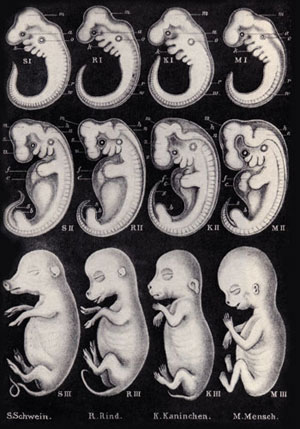Embryology Rejects The Lie of Evolution
 |
| ...My Lord encompasses |
The event of birth is a proof of a supreme creation, yet evolutionists try to make reference to it in defence of their theory. The fact that, in the creation of a new human being, every stage develops according to a very delicate design, is today an undisputed fact in the field of embryology. In this case, how do evolutionists try to interpret this fact of creation in reference to their theory?
At the end of the 19th century, the evolutionist biologist Ernst Haeckel proposed his thesis, "Ontogeny Recapitulates Phylogeny". In this thesis, Haeckel claimed that living embryos in the process of their development repeat the evolutionary process that their supposed ancestors went through. For example, he proposed that a human embryo in its mother's womb first displayed the characteristics of a fish, then of a reptile before finally turning into a human being.
Before long it was realized that this thesis did not reflect the facts. The gills that supposedly appeared in the first periods of a human embryo were actually the human inner ear canal and the parathyroid and thymus glands; the part of the embryo resembling an egg yoke was actually the sack responsible for the production of the baby's blood; the part that was thought to be the tail was identified as the human spine.
| Evolutionist Haeckel did not hesitate to produce fabricated evidence. But as science advanced, it was revealed that Haeckel's scenario was purely imaginary. |  |
These are now facts well attested in the world of science. Shortly after Haeckel proposed his theory, evolutionists themselves acknowledged that his claims were false. Two leading neo-Darwinists, George Gaylord Simpson and W. Beck acknowledged the invalidity of this theory:
Haeckel misstated the evolutionary principle involved. It is now firmly established that ontogeny does not repeat phylogeny.53
The validity of Haeckel's theory was also rejected in scientific debate in the 1920's. After this, in the 1950's, the theory was completely removed from text books.54
Fabricated Drawings
| Haeckel's Fabricated Drawings | ||
 | In Haeckel's fabricated drawings, the embryos of various living things were placed side by side in the attempt to give the impression that there was a similarity among them. In order to show the similarity between the embryo of a human being and that of a fish, Haeckel made a few additions to some parts and removed other parts. As in all other evolutionist falsifications, the goal here was to provide false evidence for evolution. But actual photographs of these embryos clearly revealed Haeckel's falsifications. These fabrications are just one proof that the theory of evolution is a deceit founded on falsehood. | In proposing his theory, Haeckel did not act contrary to the tradition of evolutionist scientists; he produced imaginary drawings to illustrate his ideas. Even when embryology developed and it was revealed that the drawings were fabricated, he acknowledged that he had not followed a different path from the rest of his colleagues:
|
It can be understood from this confession that Haeckel's attempts to use embryology as a proof for evolution are completely without foundation and amount to nothing more than sophistry. The details we have given in the course of this book, as general as they were, of the miracle of human creation are an undeniable proof of the truth of creation.
Footnotes
53 G.G.Simpson, W.Beck, An Introduction to Biology, New York, Harcourt Brace and World, 1965, s. 241
54 Keith S.Thomson, Ontogeny & Phylogeny Recapitulated, American Scientist, cilt:76 Mayıs/Haziran 1988, s. 273
55 Francis Hitching,The Neck of the Giraffe:Where Darwin Went Wrong, New York,Ticknor and Fields 1982, sf.204
